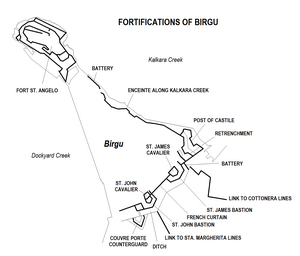Fortifications of Birgu
| Fortifications of Birgu | |
|---|---|
| Is-Swar tal-Birgu | |
| Birgu, Malta | |

St. John Bastion and the Advanced Gate
|
|

Map of Birgu's fortifications
|
|
| Coordinates | 35°53′10″N 14°31′22.8″E / 35.88611°N 14.523000°E |
| Type | City wall |
| Site information | |
| Owner | Government of Malta |
| Condition | Mostly intact |
| Site history | |
| Built |
c. 13th century–1691 (Fort St. Angelo) 1530s–18th century (rest of city walls) |
| Built by | Order of Saint John |
| Materials | Limestone |
| Battles/wars |
Attack of 1551 Great Siege of Malta (1565) Siege of Malta (1798–1800) |
| Garrison information | |
| Past commanders |
Jean de Valette (1565) |
The fortifications of Birgu (Maltese: Is-Swar tal-Birgu) are a series of defensive walls and other fortifications which surround the city of Birgu, Malta. The first fortification to be built was Fort Saint Angelo in the Middle Ages, and the majority of the fortifications were built between the 16th and 18th centuries by the Order of Saint John. Most of the fortifications remain largely intact today.
Birgu's fortifications have been on Malta's tentative list of UNESCO World Heritage Sites since 1998, as part of the Knights' Fortifications around the Harbours of Malta.
The first fortification to be built in Birgu was the Castrum Maris. It is popularly attributed to have been built by the Arabs in around 870, but the earliest references to the castle date back to around the 13th century.
In 1526, the Order of Saint John sent a commission of 8 knights to inspect the island of Malta, which had been offered to them by Emperor Charles V as a potential base following their loss of Rhodes. They described Birgu as a small defenceless town, with its only fortification being the obsolete and partially ruined Castrum Maris.
The Order eventually moved to Malta in 1530 and established itself in Birgu. The first modifications were made to the Castrum Maris, which became Fort Saint Angelo and was used as the Grand Master's residence. Later on, the entire town began to be surrounded by walls, in a similar style to the Order's earlier defences in Rhodes. Birgu's land front was built by 1540.
In 1551, Ottomans attempted to attack Birgu but turned back once they saw the new defences. They attacked again with a much larger force fourteen years later in 1565. The siege, which became known as the Great Siege of Malta, lasted for three months and Birgu was heavily bombarded. After the Great Siege, Birgu's fortifications were repaired, but soon lost most of their importance as the Order moved to its new capital Valletta, and built new fortifications there.
...
Wikipedia

